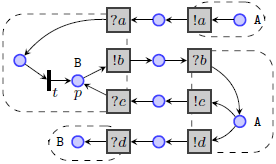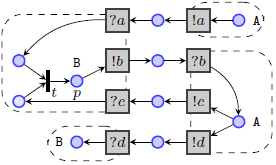Luca Fossati, Raymond Hu (homepage), Nobuko Yoshida (homepage)
2014-05-16 The Session Nets Java API (and this page) have been updated. The previous version can be found here.
Updates to this page and the linked resources (e.g. the tool implementation) are continuing
Downloads:
These APIs allow the construction of global session graphs, well-formedness validation and endpoint type conformance checking. Java 7 or above is required. Please note: this is a preliminary working version that is still under development. See below for a tutorial. For any queries regarding the APIs, please contact Raymond Hu.
Examples To compile the packaged source and run all the examples of the above paper, from the parent directory of the extracted src directory do the following. (Manually do mkdir bin first if required.)
The list of examples (as per the main method of the Examples class compiled above) and what it means to "run" them is as follows. All references to figures, pages, etc. are with respect to the above paper.
(1) Global session graph construction
Global session graphs are most conveniently constructed using the

We first create the Place, Output, Input and InternalTransition objects (from the sessnet.net package) for the initial A role structure.
// Nodes for the initial A role structure
Place p1 = new Place("A");
Output oa = new Output("a");
After creating the various place and transition objects, we use a SessionGraphBuilder (sgb) to assemble the role structure by declaring the nodes and edges via its input/output role tree builder (sgb.irt and sgb.ort) helper subcomponents. The role structure is assembled by:
SessionGraphBuilder sgb = new SessionGraphBuilder();
// Construct the first A RS
sgb.nextCorePlace(p1); // Set the core place (adds place to both the IRT and ORT)
sgb.ort.addEdge(p1, oa); // The ORT has one edge (the node is added implicitly)
sgb.finishRoleStructure(); // Finalise the RS
The finishRoleStructure method finalises the role structure being assembled (checking that it has been correctly constructed) and resets its state for assembling the next role structure.
The first B RS is constructed as follows.
// Nodes for the first B role structure
Input ia = new Input("a");
Input ic = new Input("c");
Place p2 = new Place("B");
InternalTransition t = new InternalTransition();
Place p3 = new Place("B");
Output ob = new Output("b");
// Assemble the first B role structure
sgb.nextCorePlace(p3); // Set the core place
sgb.irt.addEdge(ia, p2); // The IRT has one edge
sgb.irt.addEdge(p2, t); // The ORT is a fork with two leaves
sgb.irt.addEdge(t, p3);
sgb.irt.addEdge(ic, p3);
sgb.ort.addEdge(p3, ob);
sgb.finishRoleStructure(); // Finalise the RS
The other two role structures are constructed similarly.
// Second A role structure
Input ib = new Input("b");
Place p4 = new Place("A");
Output oc = new Output("c");
Output od = new Output("d");
sgb.nextCorePlace(p4);
sgb.irt.addEdge(ib, p4);
sgb.ort.addEdge(p4, oc);
sgb.ort.addEdge(p4, od);
sgb.finishRoleStructure();
// Final B role structure
Input id = new Input("d");
Place p5 = new Place("B");
sgb.nextCorePlace(p5);
sgb.irt.addEdge(id, p5);
sgb.finishRoleStructure();
Finally, we add the communication places between the outputs and inputs to the graph, and finalise the whole graph with the role structures and communication places assembled so far.
// Add the communication places (the edges are added implicitly)
b.addCommunicationPlace(oa, ia);
b.addCommunicationPlace(ob, ib);
b.addCommunicationPlace(oc, ic);
b.addCommunicationPlace(od, id);
Session Graph g = b.makeSessionGraph(); // Finalise the whole graph and check its construction
Finalising the graph checks resets the state of the builder object.
(2) Well-formedness validation
The makeSessionGraph method finalises the session graph and checks that it has been correctly constructed. Using the makeWellFormedSessionGraph instead will additionally check that the session graph is well-formed.
For example, consider the following modification of the graph from (1) above (corresponding to the Figure 3 (left) "bad entry" example):

This may be constructed by replacing the code for the first B role structure with the following. The remainder of the code for this new graph is the same as above.
// Modified B role structure
Place pp = new Place("B"); // Adding an additional RS place
sgb.nextCorePlace(p3);
sgb.irt.addEdge(ia, p2);
sgb.irt.addEdge(p2, t);
sgb.irt.addEdge(t, p3);
sgb.irt.addEdge(ic, pp); // Connect ?c to t via the extra place pp
sgb.irt.addEdge(pp, t);
sgb.ort.addEdge(p3, ob);
sgb.finishRoleStructure();
This graph is badly-formed because there is cycle with a transition entry node: the cycle is t -> B -> !b -> ?b -> A -> !c -> ?c -> t (omitting the unlabelled places) with entry path A -> !a -> ?a -> t. As explained in the above paper, the well-formedness condition that has been violated is (C1) in Definition 2.3.
If makeWellFormedSessionGraph method is called on the builder, the following exception will be raised (modulo the integer identifier for the offending transition):
Well-formedness error:
Entry/exit node of cycle must be a place: tau<77>
(3) Endpoint type conformance
Provided a graph has been correctly constructed and is well-formed, the makeWellFormedSessionGraph builder method returns a sessnet.net.WellFormedSessionGraph object.
To test an endpoint type for conformance, we create the sessnet.endpoint.EndpointType object that represents the syntactic type.
Using sessnet.endpoint.Parser, we create an EndpointType for TAbad (!{B<a>.?{B<b>.!{B<c>.?{B<d>.end}}}}) for the role A from the Figure 5 example. Note: the parser currently accepts only the formally defined endpoint type grammar in Section 3 of the above paper (with $\mu$ replaced by rec); it does not accept the sugared notation used in e.g. Figure 5.
Parser parser = new Parser();
String TA_bad = "!{B<a>.?{B<b>.!{B<c>.?{B<d>.end}}}}";
EndPointType et = parser.parse("A", TA_bad);
To test conformance, we then create an initial net from the session graph and pass the above EndpointType as an argument to the isConformant method of the net object.
// sg is a reference to the WellFormedSessionGraph object for Figure 5
SessionNet net = sg.makeInitialNet();
System.out.println("Checking: " + et); // et is the EndpointType from above
System.out.println("Conformance: " + net.isConformant(et));
The above code generates the following output:
Checking: A!{B<a>.A?{B<b>.A!{B<c>.A?{B<d>.end}}}}
Conformance: false
2014-05-16.